Back to > Major Fruits | Minor Fruits | Underutilized Fruits
![]()
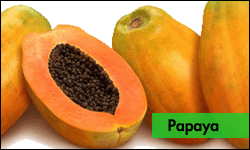 |
||
|
|
||
Distribution Cultivars:
There are many distinct, true-breeding varieties in the world 4 today. Many were developed from systematic breeding programmes and while others were from selections made by growers. Recently, transgenic varieties were developed through biotechnology processes. Papaya varieties can be self or cross-pollinated. In general, gynodioecious varieties (having hermaphrodite and female trees) are self or cross-pollinated, while the dioecious varieties (having male and female trees) are enforced cross-pollinators.
| Country | Variety | Sex Type | Flesh Color |
| Australia | Improved Petersen | dioecious | Yellow |
| Guinea Gold | hermaphrodite | Yellow | |
| Sunnybank/S7 | dioecious | Yellow | |
| Richter/Arline | dioecious | Yellow | |
| America – Mexico | Verde | – | – |
| Gialla | – | – | |
| Cera | – | – | |
| Chincona | – | – | |
| USA – Florida | Cariflora | dioecious | Yellow |
| Betty | dioecious | Yellow | |
| Homestead | dioecious | Yellow | |
| USA – Hawaii | Kapoho Solo | hermaphrodite | Yellow |
| Sunrise | hermaphrodite | Red | |
| Waimanalo | hermaphrodite | Yellow | |
| Rainbow | hermaphrodite | Yellow | |
| Venezuela | Paraguanera | – | – |
| Roja | – | Red | |
| Caribbean – Barbados | Wakefield | – | – |
| Graeme 5, and 7 | – | – | |
| Cuba | Maradol | hermaphrodite | Red |
| Trinidad | Santa Cruz Giant | – | – |
| Cedro | – | – | |
| Dominican Republic | Cartagena | hermaphrodite | Yellow |
| Asia – India | Coorg Honey Dew | hermaphrodite | Yellow |
| Coimbitor 2 | dioecious | Yellow | |
| Indonesia | Semangka | hermaphrodite | Red |
| Dampit | hermaphrodite | Red | |
| Malaysia | Eksotika | hermaphrodite | Red |
| Sekaki | hermaphrodite | Red | |
| Philippines | Cavite / Sinta | hermaphrodite | Red |
| Taiwan | Tainung No. 5 | hermaphrodite | Red |
| Thailand | Sai-nampueng | hermaphrodite | Red |
| Khaek Dam | hermaphrodite | Red | |
| South Africa | Hortus Gold | dioecious | Yellow |
| Kaapmuiden | – | Yellow | |
| Honey Gold | dioecious | Yellow |
Malaysian Papaya:
In Malaysia, papaya is a smallholder’s crop. Planting is widely spread throughout the country and the major cultivars planted are Batu Arang, Sitiawan and Subang 6. Other cultivars used as dessert fruit are Eksotika, Eksotika II and Sekaki. The Eksotikas have better eating quality than the other three cultivars in terms of flavor and taste. A major population is currently exported to Hong Kong andSingaporewhere the prices are very lucrative. These cultivars are also exported to Europe,Korea,Taiwanand theMiddle East.
Varieties:
Eksotika is a self-pollinated inbred variety, similar features to Sunrise Solo except for the larger fruit size. It is a very popular variety for export and local markets inMalaysia. Eksotika is a good bearer, about 60t/ha/year. The fruit are small to medium size (400 – 800 g). The fruit has orange-red flesh with a pleasant aroma and high sugar content of 12-14 ºBrix but does not keep well because of its soft texture. It is also quite susceptible to fruit freckles and malformed top disease.
Sekaki (also known as ‘Hong Kong’ papaya) is the second most popularly cultivated variety in Malaysiaafter Eksotika. It is a cross-pollinated variety and a prolific bearer (60-70 tonnes/ha/year) with medium sized fruit of 1.5 – 2 kg. The tree is rather dwarfed and bears low to the ground. It is also easy to manage in the field because of its tolerance to malformed top disease. Sekaki 5 fruit is attractive with smooth, even-coloured and freckle-free skin. The flesh is red, firm but sugar content is not high at 10 ºBrix or less.
In Malaysia, a F1 hybrid called Eksotika II 6 was developed from hybridization of Line 19 with its sib, Eksotika (formerly Line 20). The hybrid released in 1991, has similar features to Eksotika, but the yield is 14 – 33% higher due to the larger fruit weighing between 600 – 800 g. The appearance of the fruit is more attractive, with smooth skin and high tolerance to freckles. The flesh is firmer and the fruit stores longer, making Eksotika II more preferred than its predecessor for export.
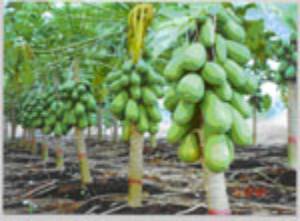 Sekaki 5, a popular large fruited variety from Malaysia |
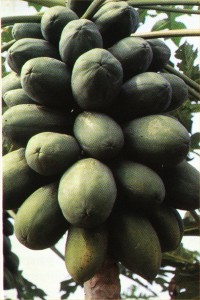 Eksotika II 6, a small fruited export variety from Malaysia |
Phillipines Papaya:
Papaya is recently grown for local fresh fruit market, for canning and for papain processing. The most popular strains of Solo papaya commercially propagated here are Kapoho and Sinrise. Many selections from these cultivars are developed and maintained by the more competitive growers like some corporate and multi-national farms. The Solo papaya is basically grown for fresh fruit since local demand is increasing especially in the local supermarkets. On the other hand, there is a favorable demand for Hawaiian Solo from the Middle East, Hong Kong, India and Singapore.
Thailand Papaya:
Papaya is one of the most important and well known economic fruit crops in Thailand which is grown throughout the country. Due to fast growth and good prices for the fruit, it has become one of the most successful crops in producing a quick return for growers. Papaya trees have been successfully planted between rows of newly planted fruit and plantation crops, including the replacements for those destroyed by bad weather.
Other varieties:
Self-pollinated varieties:
The most popular variety of papaya in the world today is the Solo. It is so called because of its small fruit, about 350 – 500g each, which is convenient as a single serving. Within this variety are many lines such as Line 5, Line 8, Line 10, Kapoho, Waimanalo and Sunrise. Kapoho is the major cultivar in Hawaii while Sunrise which is the only pink-flesh line, is widely grown in many parts of the world.
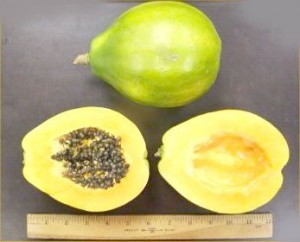 “Wainamalo” papaya |
Cross-pollinated varieties
Dioecious varieties such as Hortus Gold, Sunnybank, Betty and Cariflora, which have male and female flowers on separate trees, are enforced cross-pollinators. Hortus Gold fromSouth Africa, Sunnybank (Australia ) and Betty (Florida ,USA ) are very old varieties. The female fruits are yellow-fleshed and typically round. Cariflora fruits are also yellow fleshed, but smaller and quite tolerant to the ringspot virus disease. There are also gynodioecious varieties that are cross-pollinated such as Khaek Dam, Maradol, Cibinong andCavite. Khaegdam isThailand’s best known variety. It is vigorous, bears red-fleshed fruit about 1.2 kg with 10.6% total soluble solids content. Maradol originates fromCuba, is a short-stature variety that bears fruit very close to the ground. The fruit weighs 1-2 kg, is attractive with firm red flesh with 10-11 % total soluble solids content. It has a characteristic musky flavour. The fruit is quite susceptible to anthracnose. Cibinong is an Indonesian variety with large red-fleshed fruit (2-3 kg) and grown mainly for its high papain yield.Cavite or Pineras is a Philippine variety with large, oblong fruit weighing 1.5 – 6 kg and thick, yellow to orange flesh.
Hybrids
Commercial F1 hybrids of papaya are rare. An important hybrid developed inTaiwan that has resistance to papaya ringspot virus disease is Tainung No. 5 which was developed from a cross betweenFlorida (FL-77-5) and the Costa Rica Red.
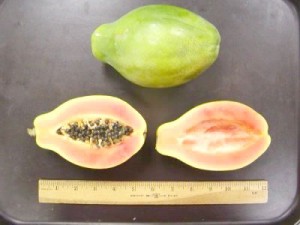 “Sunrise” papaya |
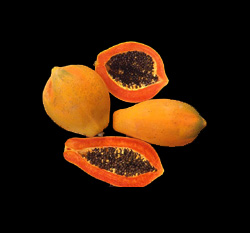 “Tainung” papaya |
Hybrid papaya varieties appear to show better adaptability, vigour and yield performance over traditional cultivars and they are expected to be more important in the future.
Clonal varieties
Honey Gold is perhaps the only known papaya clone in the world today. It is a dioecious variety fromSouth Africa which was selected and propagated from generation to generation by leafy cuttings. Clonal varieties have the advantage of greater uniformity, especially in fruit shape, which is sex-linked. Clonally propagated Honey Gold gives fairly high yields of 25 – 30 t/ha year under subtropical conditions and has been known to remain productive for 10 or more years.
Vasconcella (Carica) pentagona or Babaco, which is grown to a small extent in Ecuador and New Zealand is also exclusively clonally propagated by cuttings because of its parthenocarpic fruits.
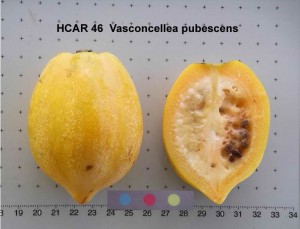 |
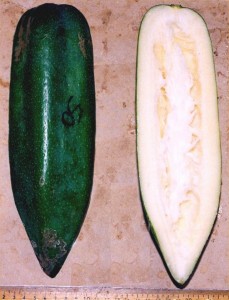 |
Transgenic varieties
The world’s first transgenic papaya was SunUp, which was transformed with coat-protein mediated resistance to papaya ringspot virus disease. Rainbow is the first transgenic commercial variety developed in Hawaii from a cross between SunUp and the conventional cultivar Kapoho. Transgenic varieties of Kamiya have also been developed by introduction of the coat-protein transgene from Rainbow through convention hybridization and backcrossing.
Transgenic papaya varieties with delayed fruit ripening and resistance to papaya ringspot virus disease are currently being actively developed in Malaysia, Thailand, Indonesia, Philippinesand Vietnamunder the Papaya Biotechnology Network of Southeast Asia.
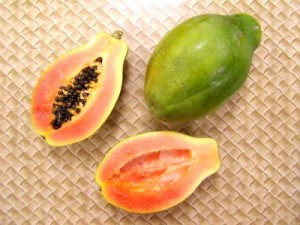 “Sun-up” GMO-papaya |
 Rainbow papaya |
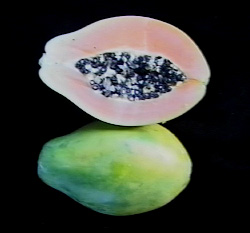 Sunrise papaya |
PAPAYA VARIETIES FROM ASEAN COUNTRIES:
Two popular groups of papaya in Asean countries consist of varieties which “bear large” and “elongated fruit”
Large and elongated fruit varieties
Subang, Sitiawan and Batu Arang fromMalaysia; Kaegdum, Kaegnuan and Sainampeung fromThailand.
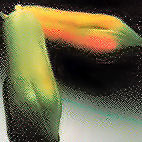 Khaek Dam |
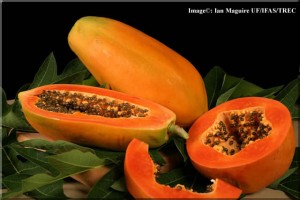 Redlady |
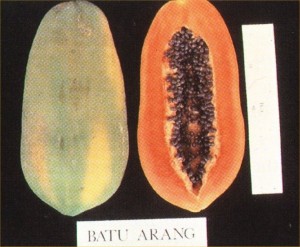 Batu Arang |
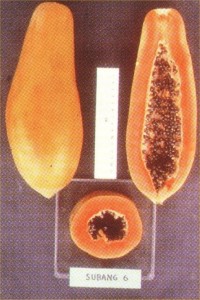 Subang6 |
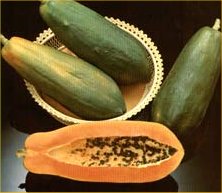 Cocoa Papaya |
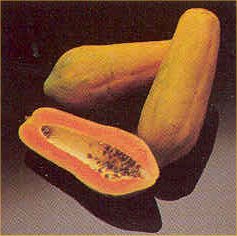 Khaek Nuan |
Uses: popular with ice stalls and hawkers because of their convenience in cutting into slices and serving in slender plastic bag.
High quality small” and “round shaped” fruits Varieties
Solo fromHawaii; Eksotika (Malaysian cultivar).
Uses: serves in halves and eaten with a spoon.
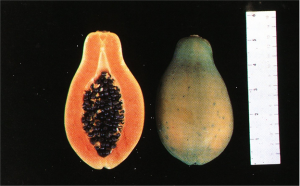 Hermaphrodite fruit of Sunrise Solo |
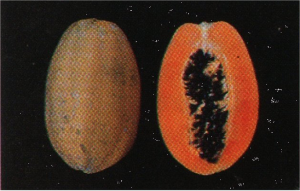 Hermaphrodite fruit of Eksotika |
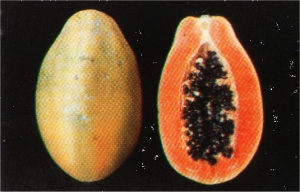 Hermaphrodite fruit of Eksotika II |
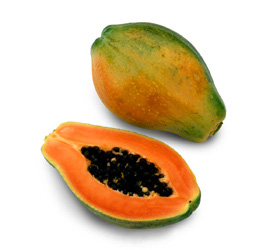 Solo papaya |
Papaya cultivars of the World:
| Country | Common Name | Name Of Cultivar |
| MALAYSIA | Betik, papaya | Eksotika (introduced by MARDI, 9th Feb 1987)Eksotika 2 (introduced by MARDI, 15th Oct 1991)Foot LongBatu Arang
Subang 6 Sitiawan |
| THAILAND | Papaya, malakor, loko, ma kuai thet | KaegdumKaegnuanKokoSainampeung |
| INDONESIA | DampitJinggaParis | |
| PHILIPINES | lechosa | SoloKapoho (Solo Type)Sunrise(Solo Type)CaviteSpecial (Pineras)
Waimanolo Sinta Red Lady Papaya (F1 Hybrid) Know You No 1 Tainung No 1 Tainung No 2 Tainung No 3 |
| SINGAPORE | Papaya | P 10 (Eksotika x local cultivar Ng Toh Seng, P5)P 15 (Eksotika x Guam Island, P2) |
| SRI LANKA | Mamao @ papaw | Rathna (recommended varieties) |
| HAWAII | Solo Type:Line 5 SoloLine 8 SoloLine 10 Solo
Kapoho Solo (Puna Solo) Sunrise Solo (best known in ASEAN) Waimanalo (Solo Line 77) Sunset Higgins (Line 17A) Wilder (Line 25) Dwarf Solo (Solo x Florida’s Betty) Big Bluestem (Purplestem x Bluestem) Bluestem Solo @ Blue Solo (Big Bluestem x Solo) Cariflora
|
|
| INDIA | Papaya | Common varieties:Coorg Honey DewPusa DwarfPusa Giant
Pusa Majesty Pusa Delicious CO.1 CO.2 CO.3 CO.4 CO.5 CO.6 Popular Varieties : Washington Burliar Long |
| AUSTRALIA | Papaw @ paw paw | BettinaImproved PetersenPetersenHybrid No 5
Yarwun Yellow Gold Cross Goldy Hong Kong GuineaGold Golden Surprise Sunny Bank |
| BRAZIL | Mamao @ Tree Melon (nickname) | BettyBettina43-A-3Zapote |
| COLOMBIA | Campo Grande. TocaimeraZapote Solo | |
| TRINIDAD and TOBAGO | Santa Cruz Grant | |
| SOUTH AFRICA | Hortus GoldHoney Gold |
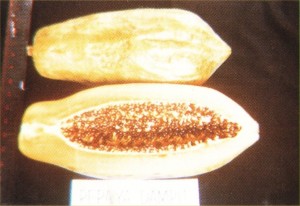 Dampit |
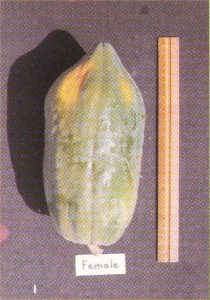 Cavite Special |
Reference:
- Chong, S.T., R. Prabhakaran and H.K. Lee. ISHS Acta Horticulturae 787: International Workshop on Tropical and Subtropical Fruits.
- Lamberts, M. and J.H. Crane. 1990. Tropical fruits. p. 337-355. In: J. Janick and J.E. Simon (eds.), Advances in new crops. Timber Press,Portland,OR.
- Morton, J. 1987. Papaya. p. 336–346. In: Fruits of warm climates. Julia F. Morton,Miami,FL.
